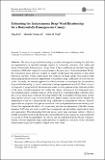| dc.contributor.author | Pan, Ying | |
| dc.contributor.author | Chamecki, Marcelo | |
| dc.contributor.author | Nepf, Heidi | |
| dc.date.accessioned | 2017-02-23T21:36:48Z | |
| dc.date.available | 2017-02-23T21:36:48Z | |
| dc.date.issued | 2016-02 | |
| dc.date.submitted | 2015-08 | |
| dc.identifier.issn | 0006-8314 | |
| dc.identifier.issn | 1573-1472 | |
| dc.identifier.uri | http://hdl.handle.net/1721.1/107147 | |
| dc.description.abstract | The mean drag–wind relationship is usually investigated assuming that field data are representative of spatially-averaged metrics of statistically stationary flow within and above a horizontally homogeneous canopy. Even if these conditions are satisfied, large-eddy simulation (LES) data suggest two major issues in the analysis of observational data. Firstly, the streamwise mean pressure gradient is usually neglected in the analysis of data from terrestrial canopies, which compromises the estimates of mean canopy drag and provides misleading information for the dependence of local mean drag coefficients on local velocity scales. Secondly, no standard approach has been proposed to investigate the instantaneous drag–wind relationship, a critical component of canopy representation in LES. Here, a practical approach is proposed to fit the streamwise mean pressure gradient using observed profiles of the mean vertical momentum flux within the canopy. Inclusion of the fitted mean pressure gradient enables reliable estimates of the mean drag–wind relationship. LES data show that a local mean drag coefficient that characterizes the relationship between mean canopy drag and the velocity scale associated with total kinetic energy can be used to identify the dependence of the local instantaneous drag coefficient on instantaneous velocity. Iterative approaches are proposed to fit specific models of velocity-dependent instantaneous drag coefficients that represent the effects of viscous drag and the reconfiguration of flexible canopy elements. LES data are used to verify the assumptions and algorithms employed by these new approaches. The relationship between mean canopy drag and mean velocity, which is needed in models based on the Reynolds-averaged Navier-Stokes equations, is parametrized to account for both the dependence on velocity and the contribution from velocity variances. Finally, velocity-dependent drag coefficients lead to significant variations of the calculated displacement height and roughness length with wind speed. | en_US |
| dc.description.sponsorship | National Science Foundation (U.S.) (Grant AGS1005363) | en_US |
| dc.publisher | Springer Netherlands | en_US |
| dc.relation.isversionof | http://dx.doi.org/10.1007/s10546-016-0137-x | en_US |
| dc.rights | Creative Commons Attribution-Noncommercial-Share Alike | en_US |
| dc.rights.uri | http://creativecommons.org/licenses/by-nc-sa/4.0/ | en_US |
| dc.source | Springer Netherlands | en_US |
| dc.title | Estimating the Instantaneous Drag–Wind Relationship for a Horizontally Homogeneous Canopy | en_US |
| dc.type | Article | en_US |
| dc.identifier.citation | Pan, Ying, Marcelo Chamecki, and Heidi M. Nepf. “Estimating the Instantaneous Drag–Wind Relationship for a Horizontally Homogeneous Canopy.” Boundary-Layer Meteorology 160, no. 1 (February 26, 2016): 63–82. | en_US |
| dc.contributor.department | Massachusetts Institute of Technology. Department of Civil and Environmental Engineering | en_US |
| dc.contributor.mitauthor | Nepf, Heidi | |
| dc.relation.journal | Boundary-Layer Meteorology | en_US |
| dc.eprint.version | Author's final manuscript | en_US |
| dc.type.uri | http://purl.org/eprint/type/JournalArticle | en_US |
| eprint.status | http://purl.org/eprint/status/PeerReviewed | en_US |
| dc.date.updated | 2017-02-02T15:19:55Z | |
| dc.language.rfc3066 | en | |
| dc.rights.holder | Springer Science+Business Media Dordrecht | |
| dspace.orderedauthors | Pan, Ying; Chamecki, Marcelo; Nepf, Heidi M. | en_US |
| dspace.embargo.terms | N | en |
| mit.license | OPEN_ACCESS_POLICY | en_US |
| mit.metadata.status | Complete | |
